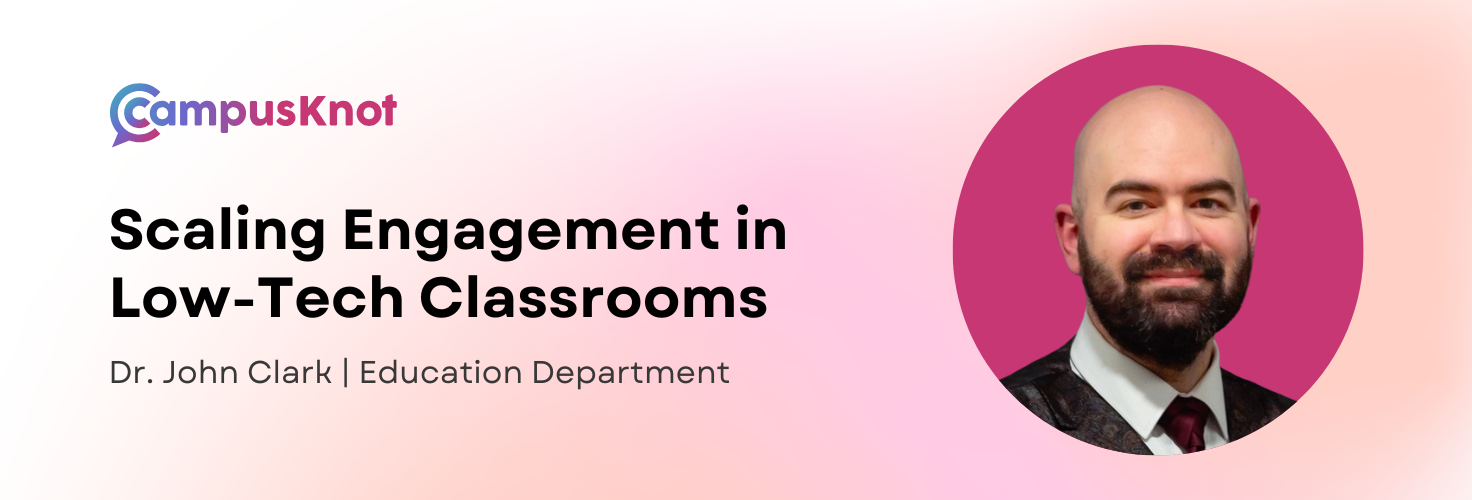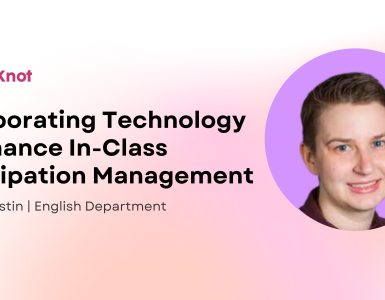When Dr. John P. Clark began using CampusKnot in Spring 2024 in his ED 312 Subject Methods course. He was looking for a solution to foster student engagement in a classroom with limited technological resources. Over the course of three consecutive semesters—Spring 2024, Fall 2024, and Spring 2025—Dr. Clark’s consistent use of CampusKnot in this Subject Methods course reveals the platform’s power to improve engagement, streamline tasks, and adapt easily to growing class sizes with limited technology.
Initial Challenges and Motivation
When Dr. Clark first considered adopting CampusKnot, his biggest challenge was a lack of reliable classroom technology. Implementing a new platform required tools that could easily adapt to this low-tech environment without adding complexity for students or himself.
CampusKnot’s mobile-forward approach became a key solution, allowing Dr. Clark and his students to engage through polls, view content, and track attendance directly from their phones, eliminating dependence on classroom desktops or Wi-Fi stability. As he noted, “The mobile versions are as good (if not better) than the desktop/web version.”
Time was another significant hurdle. Dr. Clark highlights that traditional discussion methods—whether verbal or written—often consume valuable instructional minutes and require additional time for response evaluation. Driven by a colleague’s recommendation and intrigued by CampusKnot’s AI-powered engagement tools, Dr. Clark saw an opportunity to streamline participation while maintaining academic rigor.
Yet, beyond logistical obstacles, Dr. Clark’s deeper motivation was rooted in pedagogy. He sought to foster not just participation, but meaningful cognitive engagement. He began designing activities where students would first engage with multiple-choice (MC) questions to assess foundational understanding.

Then, immediately transition his activities to open-ended (OE) prompts that required analysis, synthesis, and justification.

This layered approach transformed quick knowledge checks into opportunities for higher-order thinking, encouraging students to move from surface-level recall to deeper conceptual reasoning.
Tracking Progress Over Three Semesters
Dr. Clark’s ED 312 course offers a clear progression of how effective technology can scale with ease:
- Spring 2024: 349 interactions | 52% participation | 3.1 engagement per student
- Fall 2024: 473 interactions | 57% participation | 4.7 engagement per student
- Spring 2025: 440 interactions | 100% participation | 37.88 engagement per student
The leap in participation and engagement per student in Spring 2025 shows the lasting impact of consistent implementation, use of incentives, and leveraging mobile tools.
Student Outcomes and Faculty Insights
Dr. Clark shared that based on his records, behavioral and cognitive engagement increased compared to previous semesters, with students showing more willingness to participate, especially on sensitive or unfamiliar topics. “They are far more willing to engage through CampusKnot than prior to using it.”
While affective engagement was harder to measure, Dr. Clark felt confident that CampusKnot contributed to a more involved learning experience. Students taking Dr. Clark’s classes felt that CampusKnot helped them better engage in the classroom, “The biggest feature that helps is the anonymous question feature. Many of my students prefer to respond without the anxiety of proclaiming an incorrect answer.”

From the students’ point of view, they can connect from their own devices while collaborating and engaging during and after class. “I enjoy how comments and answers to questions can be anonymous,” while another student mentioned, “I love that it is easy to use and very new person friendly.”
Saving Time and Structuring Communication
CampusKnot became part of Dr. Clark’s prep routine. “I place a ‘CampusKnot indicator’ in my notes as I prepare them to make sure I prepare them for the right class and use them at the right time.” He also relied heavily on the Participation tab (Polls) and the mobile app to streamline grading and activity monitoring in real time.
Conclusion
Dr. Clark’s experience with the ED 312 Subject Methods course highlights how intentional pedagogy, paired with the right tools, can overcome the limitations of technology and time. Rather than letting a lack of smart boards or stable Wi-Fi define the learning environment, he embraced a mobile-first approach that met students where they were—on their devices.
By combining scaffolded assessment strategies with CampusKnot’s AI-powered engagement tools, Dr. Clark transformed participation from a passive expectation into an active, cognitively engaging process.
The steady growth in engagement rates and participation across three semesters reflects not just the effectiveness of the platform but the power of thoughtful implementation. Dr. Clark’s journey serves as a model for how meaningful engagement and pedagogical excellence can thrive, even in classrooms with limited technology.




